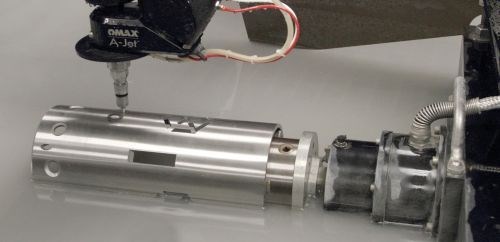Abrasive Waterjet Machining Re-Examined
After attending Omax Corporation's 20th anniversary event in Kent, Washington, I have a clearer idea of why waterjet machining has special appeal to entrepreneurs, designers, engineers and inventors, as well as many other manufacturers. This versatile, precise and capable process cuts a range of durable materials, making it easy to turn ideas into prototypes and finished products.
Share





Dr. John Cheung and Dr. John Olson founded Omax Corporation in 1993 after developing technology to make abrasive waterjet (AWJ) machining a consistent, precise process that could be easily programmed. The company celebrated the 20th anniversary of its founding on August 20, 2013 with a day-long event that included technical sessions, live cutting demonstration in tours of the company's recently expanded manufacturing facilities area
I was there to cover the event. This was my first visit to Omax’s headquarters and first trip to the Seattle, Washington area. The part of the day I found particularly interesting was the session in which several AWJ users gave presentations on how they employ the process. The users were a remarkably diverse group. Among them were individuals who started AWJ job shops as second careers, a Marine Corps officer who operated a AWJ machine in a portable shed in Afghanistan, a manufacturing engineer who wanted to produce as well as design complex parts, and a college professor eager to have his biomedical engineering students build convincing prototypes of the instrumentation they were tasked to develop.
What all seemed to have in common was an intense drive to turn ideas into parts and the parts into a usable, functioning creation. These people are motivated and excited by the prospect of getting what’s in their heads into their hands. They need to move ideas out of their minds and into material. Waterjet machining appeals to them because it is a highly versatile process. Just about any durable material can be cut with AWJ, which uses a fine, high-pressure stream of water containing garnet particles. This waterjet is the universal cutting tool. In many cases workpieces do not require elaborate fixturing. The process does not alter the properties of the material. There is no thermal stress, hardening or warping.
Of course, Omax’s proprietary developments in AWJ technology over the years have increased the versatility and capability of the process, thus enhancing its appeal to innovative, entrepreneurial manufacturers. The company used its celebration to showcase some of its most recent commercial offerings:
■ The MicroMax Jet Machining Center can cut parts or part features smaller than 300 microns from a range of materials, including exotic metals, advanced composites, polymer thermoplastics and glass.
■ A new version of its Intelli-Max software incorporates automatic tool path planning engine, simplifies control of the jet stream while cutting, improves programming of complex 3D part features and enhances machine monitoring during operation.
■ A Rotary Axis head for its Jet Machining Centers provides unlimited part rotation during cutting. This feature enhances pipe and tube cutting and other complex 3D machining tasks.
■ The Intelli-Visor monitoring system captures and shares real-time machine performance data to increase efficiency and uptime of the AWJ process.
View this slideshow for scenes captured during the event.
Related Content
-
5 Tips for Running a Profitable Aerospace Shop
Aerospace machining is a demanding and competitive sector of manufacturing, but this shop demonstrates five ways to find aerospace success.
-
Lean Approach to Automated Machine Tending Delivers Quicker Paths to Success
Almost any shop can automate at least some of its production, even in low-volume, high-mix applications. The key to getting started is finding the simplest solutions that fit your requirements. It helps to work with an automation partner that understands your needs.
-
Orthopedic Event Discusses Manufacturing Strategies
At the seminar, representatives from multiple companies discussed strategies for making orthopedic devices accurately and efficiently.

























